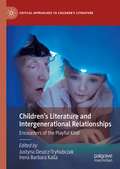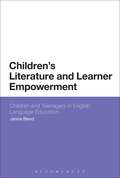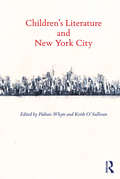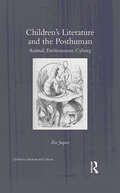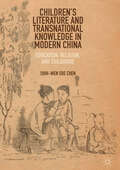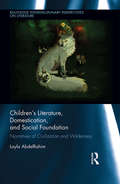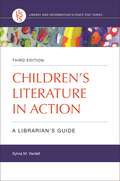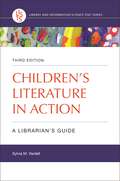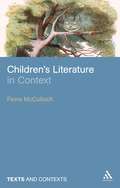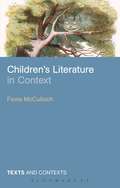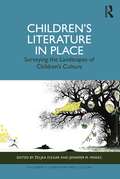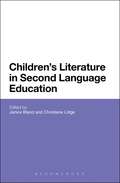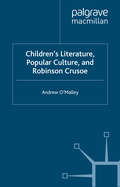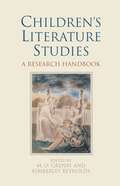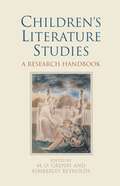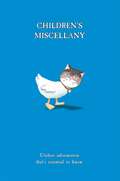- Table View
- List View
Children’s Literature and Intergenerational Relationships: Encounters of the Playful Kind (Critical Approaches to Children's Literature)
by Justyna Deszcz-Tryhubczak Irena Barbara KallaChildren’s Literature and Intergenerational Relationships: Encounters of the Playful Kind explores ways in which children’s literature becomes the object and catalyst of play that brings younger and older generations closer to one another. Providing examples from diverse cultural and historical contexts, this collection argues that children’s texts promote intergenerational play through the use of literary devices and graphic formats and that they may prompt joint play practices in the real world. The book offers a distinctive contribution to children’s literature scholarship by shifting critical attention away from the difference and conflict between children and adults to the exploration of inter-age interdependencies as equally crucial aspects of human life, presenting a new perspective for all who research and work with children’s culture in times of global aging.
Children's Literature and Learner Empowerment: Children and Teenagers in English Language Education
by Janice BlandChildren's literature can be a powerful way to encourage and empower EFL students but is less commonly used in the classroom than adult literature. This text provides a comprehensive introduction to children's and young adult literature in EFL teaching. It demonstrates the complexity of children's literature and how it can encourage an active community of second language readers: with multilayered picturebooks, fairy tales, graphic novels and radical young adult fiction. It examines the opportunities of children's literature in EFL teacher education, including: the intertexuality of children's literature as a gate-opener for canonised adult literature; the rich patterning of children's literature supporting Creative Writing; the potential of interactive drama projects. Close readings of texts at the centre of contemporary literary scholarship, yet largely unknown in the EFL world, provide an invaluable guide for teacher educators and student teachers, including works by David Almond, Anthony Browne, Philip Pullman and J.K.Rowling. Introducing a range of genres and their significance for EFL teaching, this study makes an important new approach accessible for EFL teachers, student teachers and teacher educators.
Children's Literature and Learner Empowerment: Children and Teenagers in English Language Education
by Janice BlandChildren's literature can be a powerful way to encourage and empower EFL students but is less commonly used in the classroom than adult literature. This text provides a comprehensive introduction to children's and young adult literature in EFL teaching. It demonstrates the complexity of children's literature and how it can encourage an active community of second language readers: with multilayered picturebooks, fairy tales, graphic novels and radical young adult fiction. It examines the opportunities of children's literature in EFL teacher education, including: the intertexuality of children's literature as a gate-opener for canonised adult literature; the rich patterning of children's literature supporting Creative Writing; the potential of interactive drama projects. Close readings of texts at the centre of contemporary literary scholarship, yet largely unknown in the EFL world, provide an invaluable guide for teacher educators and student teachers, including works by David Almond, Anthony Browne, Philip Pullman and J.K.Rowling. Introducing a range of genres and their significance for EFL teaching, this study makes an important new approach accessible for EFL teachers, student teachers and teacher educators.
Children's Literature and New York City (Children's Literature and Culture)
by Padraic Whyte Keith O'SullivanThis collection explores the significance of New York City in children’s literature, stressing literary, political, and societal influences on writing for young people from the twentieth century to the present day. Contextualized in light of contemporary critical and cultural theory, the chapters examine the varying ways in which children’s literature has engaged with New York City as a city space, both in terms of (urban) realism and as an ‘idea’, such as the fantasy of the city as a place of opportunity, or other associations. The collection visits not only dominant themes, motifs, and tropes, but also the different narrative methods employed to tell readers about the history, function, physical structure, and conceptualization of New York City, acknowledging the shared or symbiotic relationship between literature and the city: just as literature can give imaginative ‘reality’ to the city, the city has the potential to shape the literary text. This book critically engages with most of the major forms and genres for children/young adults that dialogue with New York City, and considers such authors as Margaret Wise Brown, Felice Holman, E. L. Konigsburg, Maurice Sendak, J. D. Salinger, John Donovan, Shaun Tan, Elizabeth Enright, and Patti Smith.
Children's Literature and New York City (Children's Literature and Culture)
by Pádraic Whyte Keith O’SullivanThis collection explores the significance of New York City in children’s literature, stressing literary, political, and societal influences on writing for young people from the twentieth century to the present day. Contextualized in light of contemporary critical and cultural theory, the chapters examine the varying ways in which children’s literature has engaged with New York City as a city space, both in terms of (urban) realism and as an ‘idea’, such as the fantasy of the city as a place of opportunity, or other associations. The collection visits not only dominant themes, motifs, and tropes, but also the different narrative methods employed to tell readers about the history, function, physical structure, and conceptualization of New York City, acknowledging the shared or symbiotic relationship between literature and the city: just as literature can give imaginative ‘reality’ to the city, the city has the potential to shape the literary text. This book critically engages with most of the major forms and genres for children/young adults that dialogue with New York City, and considers such authors as Margaret Wise Brown, Felice Holman, E. L. Konigsburg, Maurice Sendak, J. D. Salinger, John Donovan, Shaun Tan, Elizabeth Enright, and Patti Smith.
Children's Literature and the Posthuman: Animal, Environment, Cyborg (Children's Literature and Culture)
by Zoe JaquesAn investigation of identity formation in children's literature, this book brings together children’s literature and recent critical concerns with posthuman identity to argue that children’s fiction offers sophisticated interventions into debates about what it means to be human, and in particular about humanity’s relationship to animals and the natural world. In complicating questions of human identity, ecology, gender, and technology, Jaques engages with a multifaceted posthumanism to understand how philosophy can emerge from children's fantasy, disclosing how such fantasy can build upon earlier traditions to represent complex issues of humanness to younger audiences. Interrogating the place of the human through the non-human (whether animal or mechanical) leads this book to have interpretations that radically depart from the critical tradition, which, in its concerns with the socialization and representation of the child, has ignored larger epistemologies of humanness. The book considers canonical texts of children's literature alongside recent bestsellers and films, locating texts such as Gulliver’s Travels (1726), Pinocchio (1883) and the Alice books (1865, 1871) as important works in the evolution of posthuman ideas. This study provides radical new readings of children’s literature and demonstrates that the genre offers sophisticated interventions into the nature, boundaries and dominion of humanity.
Children's Literature and the Posthuman: Animal, Environment, Cyborg (Children's Literature and Culture)
by Zoe JaquesAn investigation of identity formation in children's literature, this book brings together children’s literature and recent critical concerns with posthuman identity to argue that children’s fiction offers sophisticated interventions into debates about what it means to be human, and in particular about humanity’s relationship to animals and the natural world. In complicating questions of human identity, ecology, gender, and technology, Jaques engages with a multifaceted posthumanism to understand how philosophy can emerge from children's fantasy, disclosing how such fantasy can build upon earlier traditions to represent complex issues of humanness to younger audiences. Interrogating the place of the human through the non-human (whether animal or mechanical) leads this book to have interpretations that radically depart from the critical tradition, which, in its concerns with the socialization and representation of the child, has ignored larger epistemologies of humanness. The book considers canonical texts of children's literature alongside recent bestsellers and films, locating texts such as Gulliver’s Travels (1726), Pinocchio (1883) and the Alice books (1865, 1871) as important works in the evolution of posthuman ideas. This study provides radical new readings of children’s literature and demonstrates that the genre offers sophisticated interventions into the nature, boundaries and dominion of humanity.
Children’s Literature and Transnational Knowledge in Modern China: Education, Religion, and Childhood
by Shih-Wen Sue ChenThis book examines the development of Chinese children’s literature from the late Qing to early Republican era. It highlights the transnational flows of knowledge, texts, and cultures during a time when children’s literature in China and the West was developing rapidly. Drawing from a rich archive of periodicals, novels, tracts, primers, and textbooks, the author analyzes how Chinese children’s literature published by Protestant missionaries and Chinese educators in the late nineteenth and early twentieth centuries presented varying notions of childhood. In this period of dramatic transition from the dynastic Qing empire to the new Republican China, young readers were offered different models of childhood, some of which challenged dominant Confucian ideas of what it meant to be a child. This volume sheds new light on a little-explored aspect of Chinese literary history. Through its contributions to the fields of children’s literature, book history, missionary history, and translation studies, it enhances our understanding of the negotiations between Chinese and Western cultures that shaped the publication and reception of Chinese texts for children.
Children's Literature Collections: Approaches to Research (PDF) (Critical Approaches to Children's Literature)
by Keith O'Sullivan Pádraic WhyteThis book provides scholars, both national and international, with a basis for advanced research in children’s literature in collections. Examining books for children published across five centuries, gathered from the collections in Dublin, this unique volume advances causes in collecting, librarianship, education, and children’s literature studies more generally. It facilitates processes of discovery and recovery that present various pathways for researchers with diverse interests in children’s books to engage with collections. From book histories, through bookselling, information on collectors, and histories of education to close text analyses, it is evident that there are various approaches to researching collections. In this volume, three dominant approaches emerge: history and canonicity, author and text, ideals and institutions. Through its focus on varied materials, from fiction to textbooks, this volume illuminates how cities can articulate a vision of children's literature through particular collections and institutional practices.
Children's Literature Comes of Age: Toward a New Aesthetic (Routledge Library Editions: Children's Literature)
by Maria NikolajevaOriginally published in 1996. A detailed analysis of the art of children's literature covering world literature for children, children's literature as a canonical art form, the history of children's literature from a semiotic perspective, and epic, polyphony, chronotope, intertextuality, and metafiction in children's literature.
Children's Literature Comes of Age: Toward a New Aesthetic (Routledge Library Editions: Children's Literature)
by Maria NikolajevaOriginally published in 1996. A detailed analysis of the art of children's literature covering world literature for children, children's literature as a canonical art form, the history of children's literature from a semiotic perspective, and epic, polyphony, chronotope, intertextuality, and metafiction in children's literature.
Children's Literature, Domestication, and Social Foundation: Narratives of Civilization and Wilderness (Routledge Interdisciplinary Perspectives on Literature)
by Layla AbdelRahimThis study of children's literature as knowledge, culture, and social foundation bridges the gap between science and literature and examines the interconnectedness of fiction and reality as a two-way road. The book investigates how the civilized narrative orders experience by means of segregation, domestication, breeding, and extermination, arguing instead that the stories and narratives of wilderness project chaos and infinite possibilities for experiencing the world through a diverse community of life. AbdelRahim engages these narratives in a dialogue with each other and traces their expression in the various disciplines and books written for both children and adults, analyzing the manifestation of fictional narratives in real life. This is both an inter- and multi-disciplinary endeavor that is reflected in the combination of research methods drawn from anthropology and literary studies as well as in the tracing of the narratives of order and chaos, or civilization and wilderness, in children's literature and our world. Chapters compare and contrast fictional children's books that offer different real-world socio-economic paradigms, such as A.A. Milne's Winnie-the-Pooh projecting a civilized monarcho-capitalist world, Nikolai Nosov's trilogy on The Adventures of Dunno and Friends presenting the challenges and feats of an anarcho-socialist society in evolution from primitivism towards technology, and Tove Jansson's Moominbooks depicting the harmony of anarchy, chaos, and wildness. AbdelRahim examines the construction, transmission, and acquisition of knowledge in children’s literature by visiting the very nature of literature, culture, and language and the civilized structures that domesticate the world. She brings radically new perspectives to the knowledge, culture, and construction of human beings, making an invaluable contribution to a wide range of disciplines and for those engaged in revolutionizing contemporary debates on the nature of knowledge, human identity, and the world.
Children's Literature, Domestication, and Social Foundation: Narratives of Civilization and Wilderness (Routledge Interdisciplinary Perspectives on Literature)
by Layla AbdelRahimThis study of children's literature as knowledge, culture, and social foundation bridges the gap between science and literature and examines the interconnectedness of fiction and reality as a two-way road. The book investigates how the civilized narrative orders experience by means of segregation, domestication, breeding, and extermination, arguing instead that the stories and narratives of wilderness project chaos and infinite possibilities for experiencing the world through a diverse community of life. AbdelRahim engages these narratives in a dialogue with each other and traces their expression in the various disciplines and books written for both children and adults, analyzing the manifestation of fictional narratives in real life. This is both an inter- and multi-disciplinary endeavor that is reflected in the combination of research methods drawn from anthropology and literary studies as well as in the tracing of the narratives of order and chaos, or civilization and wilderness, in children's literature and our world. Chapters compare and contrast fictional children's books that offer different real-world socio-economic paradigms, such as A.A. Milne's Winnie-the-Pooh projecting a civilized monarcho-capitalist world, Nikolai Nosov's trilogy on The Adventures of Dunno and Friends presenting the challenges and feats of an anarcho-socialist society in evolution from primitivism towards technology, and Tove Jansson's Moominbooks depicting the harmony of anarchy, chaos, and wildness. AbdelRahim examines the construction, transmission, and acquisition of knowledge in children’s literature by visiting the very nature of literature, culture, and language and the civilized structures that domesticate the world. She brings radically new perspectives to the knowledge, culture, and construction of human beings, making an invaluable contribution to a wide range of disciplines and for those engaged in revolutionizing contemporary debates on the nature of knowledge, human identity, and the world.
Children's Literature in Action: A Librarian's Guide (Library and Information Science Text Series)
by Sylvia M. VardellThis practitioner-oriented introduction to literature for children ages 5–12 covers the latest trends, titles, and tools for choosing the best books and materials as well as for planning fun and effective programs and activities.The third edition of Children's Literature in Action provides an activity-oriented survey of children's literature for undergraduate and graduate students seeking licensure and degrees that will lead to careers working with children in schools and public libraries. Author Sylvia M. Vardell draws on her 30 years of university teaching and extensive familiarity with the major textbooks in the area of children's literature to deliver something different: a book that focuses specifically on the perspective and needs of the librarian, with emphasis on practical action and library applications. Its contents address seven major genres: picture books, traditional tales, poetry, contemporary realistic fiction, historical fiction, fantasy, and informational books. Each chapter includes practical applications for the educator who shares books with children and who develops literature-based instruction. Chapters are enriched by author comments, collaborative activities, featured books, special topics, and activities including selected awards and celebrations, historical connections, recommended resources, issues for discussion, and assignment suggestions. This new edition incorporates the 2018 AASL National School Library Standards.
Children's Literature in Action: A Librarian's Guide (Library and Information Science Text Series)
by Sylvia M. VardellThis practitioner-oriented introduction to literature for children ages 5–12 covers the latest trends, titles, and tools for choosing the best books and materials as well as for planning fun and effective programs and activities.The third edition of Children's Literature in Action provides an activity-oriented survey of children's literature for undergraduate and graduate students seeking licensure and degrees that will lead to careers working with children in schools and public libraries. Author Sylvia M. Vardell draws on her 30 years of university teaching and extensive familiarity with the major textbooks in the area of children's literature to deliver something different: a book that focuses specifically on the perspective and needs of the librarian, with emphasis on practical action and library applications. Its contents address seven major genres: picture books, traditional tales, poetry, contemporary realistic fiction, historical fiction, fantasy, and informational books. Each chapter includes practical applications for the educator who shares books with children and who develops literature-based instruction. Chapters are enriched by author comments, collaborative activities, featured books, special topics, and activities including selected awards and celebrations, historical connections, recommended resources, issues for discussion, and assignment suggestions. This new edition incorporates the 2018 AASL National School Library Standards.
Children's Literature in Context (Texts and Contexts)
by Fiona McCullochChildren's Literature in Context is a clear, accessible and concise introduction to children's literature and its wider contexts. It begins by introducing key issues involved in the study of children's literature and its social, cultural and literary contexts. Close readings of commonly studied texts including Lewis Carroll's Alice books, The Wonderful Wizard of Oz, The Lion, the Witch and the Wardrobe, the Harry Potter series and the His Dark Materials trilogy highlight major themes and ways of reading children's literature. A chapter on afterlives and adaptations explores a range of wider cultural texts including the film adaptations of Harry Potter, The Chronicles of Narnia and The Golden Compass. The final section introduces key critical interpretations from different perspectives on issues including innocence, gender, fantasy, psychoanalysis and ideology. 'Review, Reading and Research' sections give suggestions for further reading, discussion and research. Introducing texts, contexts and criticism, this is a lively and up-to-date resource for anyone studying children's literature.
Children's Literature in Context (Texts and Contexts)
by Fiona McCullochChildren's Literature in Context is a clear, accessible and concise introduction to children's literature and its wider contexts. It begins by introducing key issues involved in the study of children's literature and its social, cultural and literary contexts. Close readings of commonly studied texts including Lewis Carroll's Alice books, The Wonderful Wizard of Oz, The Lion, the Witch and the Wardrobe, the Harry Potter series and the His Dark Materials trilogy highlight major themes and ways of reading children's literature. A chapter on afterlives and adaptations explores a range of wider cultural texts including the film adaptations of Harry Potter, The Chronicles of Narnia and The Golden Compass. The final section introduces key critical interpretations from different perspectives on issues including innocence, gender, fantasy, psychoanalysis and ideology. 'Review, Reading and Research' sections give suggestions for further reading, discussion and research. Introducing texts, contexts and criticism, this is a lively and up-to-date resource for anyone studying children's literature.
Children’s Literature in Place: Surveying the Landscapes of Children’s Culture (Children's Literature and Culture)
by Željka Flegar Jennifer M. MiskecChildren’s Literature in Place: Surveying the Landscapes of Children’s Culture is an edited collection dedicated to individual, international, and interdisciplinary considerations of the places and spaces of children’s literature, media, and culture, from content to methodology, in fictional, virtual, and material settings. This volume proposes a survey of the changing landscapes of children’s culture, the expected and unexpected spaces and places that emerge as and because of children’s culture. The places and spaces of children’s literature are varied and diverse. By making place studies a guiding principle, this book builds on the impressive body of international research on place in children’s literature, media, and culture to bring together and provide a comprehensive overview of how to study place in children’s and young adult literature. This volume provides a wide range of approaches and international perspectives of place in children’s literature, media, and culture and contributes to this growing and relevant field by showcasing various scholarly aspects and approaches to children’s literature, and the place of children’s literature in the context of international scholarship.
Children’s Literature in Place: Surveying the Landscapes of Children’s Culture (Children's Literature and Culture)
Children’s Literature in Place: Surveying the Landscapes of Children’s Culture is an edited collection dedicated to individual, international, and interdisciplinary considerations of the places and spaces of children’s literature, media, and culture, from content to methodology, in fictional, virtual, and material settings. This volume proposes a survey of the changing landscapes of children’s culture, the expected and unexpected spaces and places that emerge as and because of children’s culture. The places and spaces of children’s literature are varied and diverse. By making place studies a guiding principle, this book builds on the impressive body of international research on place in children’s literature, media, and culture to bring together and provide a comprehensive overview of how to study place in children’s and young adult literature. This volume provides a wide range of approaches and international perspectives of place in children’s literature, media, and culture and contributes to this growing and relevant field by showcasing various scholarly aspects and approaches to children’s literature, and the place of children’s literature in the context of international scholarship.
Children's Literature in Second Language Education
by Janice Bland Christiane LütgeBringing together leading scholars and teacher educators from across the world, from Europe and the USA to Asia, this book presents the latest research and new perspectives into the uses of children's literature in second language teaching for children and young adults. Children's Literature in Second Language Education covers such topics as extensive reading, creative writing in the language classroom, the use of picturebooks and graphic novels in second language teaching and the potential of children's literature in promoting intercultural education. The focus throughout the book is on creative approaches to language teaching, from early years through to young adult learners, making this book an essential read for those studying or embarking on second language teaching at all levels.
Children's Literature in Second Language Education
by Janice Bland Christiane LütgeBringing together leading scholars and teacher educators from across the world, from Europe and the USA to Asia, this book presents the latest research and new perspectives into the uses of children's literature in second language teaching for children and young adults. Children's Literature in Second Language Education covers such topics as extensive reading, creative writing in the language classroom, the use of picturebooks and graphic novels in second language teaching and the potential of children's literature in promoting intercultural education. The focus throughout the book is on creative approaches to language teaching, from early years through to young adult learners, making this book an essential read for those studying or embarking on second language teaching at all levels.
Children's Literature, Popular Culture, and Robinson Crusoe (Critical Approaches to Children's Literature)
by A. O'MalleyThis study of the afterlife of Robinson Crusoe offers insights into the continued popularity and relevance of Crusoe's story and how modern conceptions of childhood are shaped by nostalgia and ideas of 'the popular'. Examining many adaptations in a variety of formats, it reconsiders the place Crusoe has occupied in our culture for three centuries.
Children's Literature Studies: A Research Handbook
by Grenby, Matthew O; Reynolds, KimberleyChildren's literature is a rapidly expanding field of research which presents students and researchers with a number of practical and intellectual challenges. This research handbook is the first devoted to the specialist skills and complexities of studying children's literature at university level. Bringing together the expertise of leading international scholars, it combines practical advice with in-depth discussion of critical approaches. Wide- ranging in approach, Children's Literature Studies: A Research Handbook:• considers 'children's literature' in its fullest sense, examining visual texts (such as picturebooks), films, computer games and other 'transformed' texts, as well as more traditional modes of writing for children• offers a step-by-step guide to devising, starting and carrying out a research project (such as a dissertation or thesis), and advice on what kinds of research it is possible and profitable to undertake• surveys the different methodologies and theoretical approaches used by children's literature scholars• includes case studies, questions and exercises to reinforce ideas discussed in each chapter• provides lists of further reading and a specialist glossary that will remain a useful reference resource.This handbook will be an essential companion for those studying children's literature, whether as undergraduates, postgraduates, or beyond.
Children's Literature Studies: A Research Handbook
by Grenby, Matthew O; Reynolds, KimberleyChildren's literature is a rapidly expanding field of research which presents students and researchers with a number of practical and intellectual challenges. This research handbook is the first devoted to the specialist skills and complexities of studying children's literature at university level. Bringing together the expertise of leading international scholars, it combines practical advice with in-depth discussion of critical approaches.Wide- ranging in approach, Children's Literature Studies: A Research Handbook:- Considers 'children's literature' in its fullest sense, examining visual texts (such as picturebooks), films, computer games and other 'transformed' texts, as well as more traditional modes of writing for children- Offers a step-by-step guide to devising, starting and carrying out a research project (such as a dissertation or thesis), and advice on what kinds of research it is possible and profitable to undertake- Surveys the different methodologies and theoretical approaches used by children's literature scholars- Includes case studies, questions and exercises to reinforce ideas discussed in each chapter- Provides lists of further reading and a specialist glossary that will remain a useful reference resourceThis handbook will be an essential companion for those studying children's literature, whether as undergraduates, postgraduates, or beyond.
Children's Miscellany: Useless Information That's Essential To Know!
by Dominique EnrightPacked full of fascinating facts that will astound and amaze, this irreverent but intelligent guide to the weird, wild and wonderful explores the bizarre truth about history, the animal kingdom, plants, planets and people.
